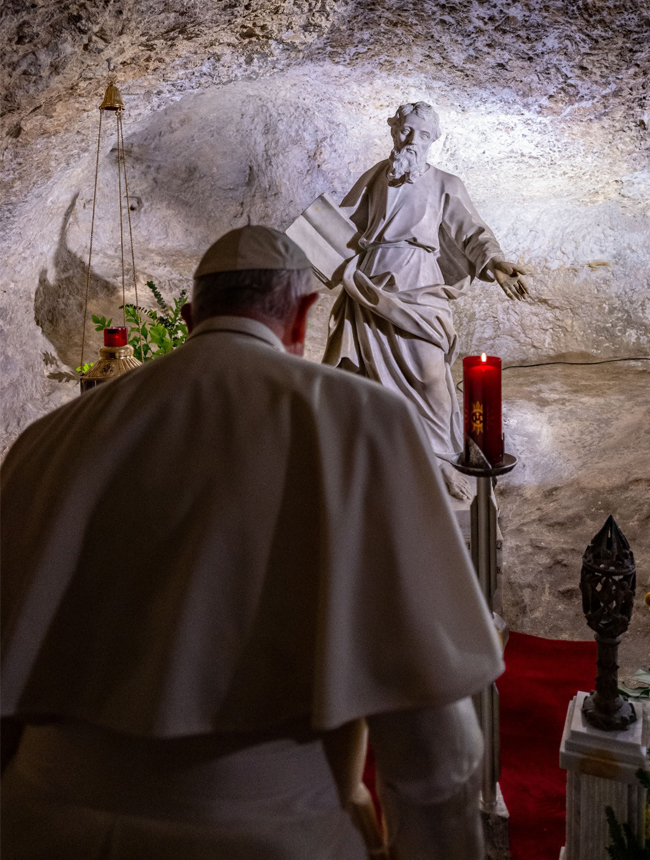Sponsored Content
Written by: Jean Pierre Fava Dip., B.Sc. (Hons.), M.Sc., H.Sc. Manager, Malta Faith Tourism & co-authored with Daniel Esparza, Writer, Aleteia
The Maltese are well known for their deep multi-millennial Catholic faith. Malta is living evidence of the 2,000-year-old history of Christianity from its origins. In this article I present our faith tourism pillars, to help travelers and pilgrims understand how faith, history, culture and tradition blend to form the history of our nation.
The Maltese Christian community is as ancient as that of Ephesus, Jerusalem, Corinth and Rome, thanks to the Apostle Paul. The Apostle of the Gentiles’ shipwreck in AD 60 was providential. Paul preached the Good News to our forefathers. The inhabitants were impressed by his eloquent words and converted when they witnessed the miracles he performed in the name of Christ. Due to this ancient Christian heritage, it is only natural that the country has more than one church per square kilometer. In fact, there are enough churches in the Archipelago for you to attend Mass in a different one, almost every day, for a whole year: a whooping 359 in total. Even the smallest of the islands of the Maltese archipelago, Comino has a chapel – for its one or two residents!

The Paleo-Christian monumental heritage of these Islands, apart from attesting to the vitality of the early Maltese Christian community, places Malta among the more important archaeological centers in the study of the ancient Christian world. The varied forms of architectural designs within our underground Christian catacombs and the special characteristics that are the hallmark of prevailing customs and usages during the first centuries of the Christian Era make the Maltese Paleo-Christian heritage unique.

Another singular aspect of Maltese Christianity is the intense devotion to the Blessed Virgin Mary. When the Apostle was shipwrecked, he was accompanied by the Luke who wrote in his Gospel an anthology of Marian doctrines. Hence, it is probable that Luke spoke to the Maltese about the Virgin, and our forefathers warmly embraced his words. Various devotions, historical artifacts and spoken traditions throughout the centuries point to the fact that the locals who had accepted the Faith were devotees of the Blessed Virgin. So, we can also classify Malta as one of the earliest Marian shrines. Indeed, most of our churches are dedicated to Mary, and some of them are known for being places where countless special, miraculous graces have been granted to many. The centuries-old devotions and numerous ex-votos found in Marian Sanctuaries dotting the Islands confirm this. Pilgrims visit in droves to either ask the Virgin for a special grace as much as to thank her for those already received. Here I cannot fail to mention the National Marian Shrines of Our Lady of Mellieha and Our Lady of Ta’ Pinu National Shrine.

As a result of our ancient Christian heritage and devotions, Malta also brims with Caminos. In fact, a collaborative project between the MTA and XirCammini has revived ancient Walks and is developing others – one of them being part of the legendary Way of Saint James. The Islands are a destination that ignites the soul and nourishes the spirit. Traversing the Walks is an invitation to embark on a voyage of spiritual discovery. These paths guide pilgrims through the islands’ diverse landscapes, from rolling hills to villages and cities, through rugged coastlines and serene countryside dotted with ancient chapels. Indeed, each step becomes an act of devotion, a way to connect with God and others, while deepening one’s spiritual journey. The footsteps echo the pilgrims of centuries past, Saint Paul himself included, infusing the journey with a sense of collective pilgrimage and a shared spiritual heritage.











